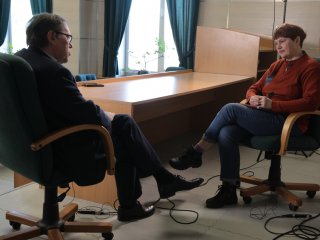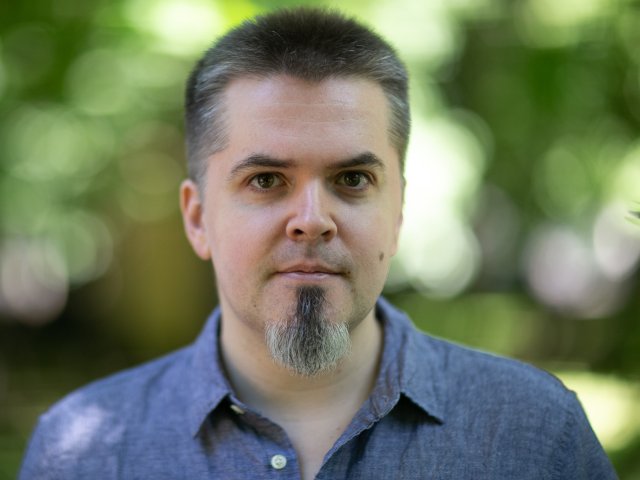Professor A. P. Kozlov created a new theory of tumors that will take oncology to a new level. In a conversation, the professor will tell us what theory it is and what prospects it offers.
Andrey Petrovich Kozlov is a Dr. Sc. in Biology, Professor, Head of the Laboratory at the N. I. Vavilov Institute of General Genetics of the Russian Academy of Sciences, Professor of the Saint Petersburg Polytechnic University, developed a conceptually new biological theory of evolution, in which a significant part is assigned to the tumor evolution. According to him, studies in this field will take the mankind to a new level in understanding the nature of tumors and allow us to fight them more successfully.
– So, Andrey Petrovich, your theory is dedicated to cancer, right?
– It is dedicated to evolution and the evolutionary role of tumors not only in oncology but also in biology. In recent years, there emerged a new area in biological sciences relating to health sciences. These are Darwinian medicine, evolutionary epidemiology, and evolutionary oncology. Working in evolutionary oncology, we suggest solving some biological problems. Thus, depending on tasks at hand, we can speak about a new cancer theory or a new biological theory. They do not contradict one another, but complements each other.
– Andrey Petrovich, is cancer a part of the evolution?
– This is an interesting question. After graduation from the Saint Petersburg University, I entered the postgraduate studies of the N. N. Petrov Cancer Institute in Saint Petersburg. This is the first Russian and Soviet cancer institute, which was founded by the prominent oncologist Nikolay Nikolayevich Petrov. So, after graduation, we had to take qualifying examinations for the Candidate degree based on the General Oncology by Petrov. It’s there that I first read it and was very surprised that tumors were inherent not only in humans but also in animals and plants. This was a revelation.
– I know about animals but plants?
– And plants, too. This is still a revelation for many. I remember delivering a report at the U.S. National Cancer Institute where I also studied as a postdoc. And a senior researcher, a geneticist, told me: “Aren’t tumors only found in people?” An outstanding institute, you see, and they still don’t know that tumors have an evolutionary nature inherent in all living things. Biology is a very vast, very complex science. It diverges, deals with tips of branches and tips of leaves on these trees. It chooses the path of specialization. But we need to cover all the leaves. For that to happen, we need new theories.
– So, Andrey Petrovich, when did malignant neoplasms appear? Were they originally inherent in the human nature or did they appear over time, evolutionarily?
– Evolutionarily, tumors appeared a long time ago. The comparative oncology started in the 19th century, and after humans, tumors were first found in domestic animals and then in the fish we eat. Throughout the 20th century, the comparative oncology accumulated so many materials that we can now say that tumors are all over the phylogenetic tree. This is first.
Second. It turns out that oncogenes and tumor suppressors are the oldest classes of genes after housekeeping genes. It means that someone needed this from the earliest stages of multicellular evolution. Interestingly, we explored it on purpose and published a paper in a good journal in 2019. There were great reviews. We found that the evolution of oncogenes and suppressor genes went alongside differentiation genes. This is our theory and it was predicted and proved with good statistics that the evolutionary curves are almost the same. This is the second part of the answer to your question: tumors are an old thing.
– And not just old, but necessary for evolution.
– Exactly. If you follow on from modern biological theories, none of them can solve the problem of cancer. Of course, science is always on the go, there have been many advances, but there are also many types of cancer. It’s not growing less — rather on the contrary. Nature triggers new hypotheses and theories. They do not appear out of thin air. There are questions that need to be answered. And their numbers are growing.
– Mankind perceives cancer as a terrible enemy that we must defeat. So, it’s a wrong approach?
– Not entirely correct. The fact is that the concept of a tumor is broader than cancer. Cancer is just a consequence of a tumor. But we know that there are benign and malignant tumors. And it’s clear that doctors are interested in malignant tumors and no one takes interest in benign ones, because what’s the point if there’s no problem?
When we started to address the problem of early diagnosis, we found a huge number of unknown tumors. The clinical physicians didn’t understand how to classify them. So, early diagnosis was just fueling the problem expansion, but not vice versa. But mortality rates did not rise. And this difference between the number of diagnosed cases and the number of deaths came to be called known “pseudo diseases.” There is something that defies explanation. It turns out that the problem is much broader than just malignant tumors and we need to understand why not all tumors can kill. If we understand it, we can handle malignant tumors, too. For many years, it was thought that tumor tissue was something unwanted. But that’s not true. Tumors are by no means useless tissue. It is important and can participate in many different processes.
– For example?
– First and foremost, of course, is excess cell mass. We can see that progressive evolution has always been about generating additional cell masses. At the cost of what? We know that there are stem cells and they are always dividing and being self-regulated depending on the functional needs. If they break this regulation and this feedback, it’s already an autonomous process and it’s already a tumor. So, it turns out that we meet tumors as far as the eye can see.
Now take a look. It turns out that a huge number of genes are activated and expressed in tumors that do not otherwise work anywhere else. According to our theory, which we have confirmed through experiments, evolutionarily new genes are activated in tumors. Especially genes relating to morphological innovations and new functions, such as, for example, the immunoglobulin locus.
– I heard that, according to your theory, it was tumor cells that became precursors of many human organs.
– Yes, and we confirmed it. If evolutionarily new organs come from some tumor structures, then they should have tumor signs. Such evolutionarily new organs are placenta, mammary gland, and prostate. And there are many signs of tumors in them. They are all invasive in the course of their development. We see regulated invasiveness in the placenta, mammary gland, and prostate.
– And these are all reproductive organs, which is interesting.
– In my book, I analyzed the example of the placenta. I even coined a term “tumor-like organ.” Placenta has a lot of tumor-like signs. After the book was released, there was a conference in Europe dedicated to the placenta’s similarity to tumors. There were people who studied the placenta. They asked: “Okay, they have much in common, but are there any differences?” There is one difference — regulation. It turns out that placenta is a regulated tumor, that is, it is a tumor that has acquired a function, and it is regulated.
– And what about the mammary gland and prostate?
– The same. The youngest organs, the ones most affected by cancer. It turns out that they drag along tumor signs. They came from tumors. That’s why, they are the organs that are hit by cancer more often than others. When I was a student, I noticed some of the signs of fat tissues that indicate that this is an organ. As mammals, we have three or four fat tissues: white, brown, beige, and bone marrow. And it turns out that they function as one organ. Many people say that fat tissues are an endocrine organ. But it’s not just an endocrine organ — it’s an organ that provides and regulates energy and glucose exchange. So, this is an organ alright. It is removed anatomically, consists of several depots, which are innervated by separate bundles and supplied by blood vessels.
Next. It turns out that even though fat metabolism is an ancient trait, as energy is stored in the form of fat droplets, the organ is evolutionarily new to mammals. Such things happen. Brown fat tissue is generally found only in mammals. It turns out that the number of specific signs of the fat organ reaches a maximum level in mammals.
– If it’s a young organ, so it must have tumor signs?
– Yes, and I started looking for them. And I found all the major tumor signs. Theory is like a lamp. Everything works when lit by a theory. We switched on another lamp that tells us what follows from where.
– What does it entail?
– That obesity is a cancer problem. This is a very recent discovery of ours. Last month, the N. N. Petrov Cancer Institute hosted an all-Russia webinar on “Tumor Signs of Human Fat Tissues.” Oncologists are very curious about it. It turns out that we can potentially combine different categories of technologies, which have been developed to fight obesity and cancer.
– Andrey Petrovich, any theory can be put to words. How do you formulate your theory?
– All theories have an established structure. Every theory must have a main hypothesis. Our main hypothesis is that inherited tumors in the early stages of proliferation in the course of evolution provide the evolving multicellular organism additional cell masses to express evolutionarily new genes, which emerge in the germ plasm, rather than in tumors. That is, a tumor is a test ground for expression and, thus, tumors contribute to the formation of new types of cells, tissues, and organs.
In addition, the theory structure includes nontrivial explanations, nontrivial predictions, and analysis of references to other theories. One of the signs that a theory is born is the publication of a book, a monograph on the subject. In our publications, we have cited 1,500 references. We made a number of nontrivial predictions confirmed through experiments and gave a number of nontrivial explanations.
In particular, we explain what constitutes a transitional form in the complexity step of progressive evolution. In our opinion, these are the populations of organisms carrying tumors. They may also be invisible in the fossil record when the leap apparently took place. A tumor in this sense is a search engine. It turns out that for transitions, evolutionary leaps, we need an intermediate state, metastable, not very stable, maybe pathological, but it ensures this transition.
– I know that your students are already doing experiments according to your theory. And what do they, these experiments, demonstrate?
– Yes, they are spoiling for a fight. The most nontrivial prediction is that evolutionarily new genes have to work, be activated, and be expressed in tumors. And we discovered these genes. It turned out that this group of genes are potential targets for anti-tumor technologies. And another prediction is that tumors can acquire functions in the body. Using goldfish caps as an example, we proved this through experiments. This cap, which breeders selected over its beauty, is actually a benign tumor. On the one hand, it has all the traits of a normal organ — symmetry, localization, anatomical development at certain stages. But, on the other hand, it has signs of a tumor. It grows so huge that the fish can swim only with its fins up.
– That is, this cap is getting in its way.
– It covers the eyes, the gill slits. This cap is an evolutionarily young organ. Just like the prostate in men. It’s a benign tumor that grows throughout life and almost all elderly men have benign prostatic hyperplasia. So it’s an organ that hasn’t finished its formation yet. And understanding it is very important to us. If that’s the case, we have to learn to live with tumors.
– That’s what I wanted to ask you about. It turns out that we don’t have to fight the tumor every time. We have to learn to live with it, so that we don’t harm each other?
– We have to fight it, but the fight for total annihilation is the paradigm of the 19th century, the paradigm of Ehrlich’s magic bullet.
– It’s like this even now.
– But it is time for a paradigm change. The magic bullet paradigm is the outdated ideology of the late 19th to the mid-20th century. It turns out that chemotherapy kills the immune system and many other things.
– Often, it’s not the cancer, but the chemotherapy that kills the person.
– The clinical physicians are more often than not saying that we shouldn’t kill the immune system, let’s control the tumor. This leads to the concept of adaptive, suboptimal, and immunological therapy, which is enjoying a tremendous success right now. And we’re trying to understand this puzzle evolutionarily.
– How is your theory perceived by colleagues and clinical physicians?
– The clinical physician is the best listener. A person who treats and sees death every day would not seem to be the most sympathetic listener to evolutionary texts, but it turns out that this is the case, because the theory opens their eyes, they see new ways, and they just need to feel them somehow. Which is what we are trying to do.
– Which of your predictions in particular have already come true?
–
Many years ago, I predicted that if the theory was correct, the number of oncogenes should correspond to the number of differentiated cell types. If evolution is fueled by tumors and oncogenes are associated with tumors, then there should be as many oncogenes as the types of differentiated cells. When we started the study, there were 12 known oncogenes and about 200 differentiated cell types. Now there are about 400 cell types and about 300 oncogenes. And oncogenes evolve alongside differentiation genes. Here’s an example of a prediction that worked.
There are also other predictions. For example, we claim that there are evolutionarily new genes working in tumors. The students say right away: “And let’s take a computer and do the math to see how they, these genes, evolve?” And we do that. We look at evolutionarily new fish genes. Some of them are expressed in tumors. According to the theory, they should acquire progressive functions. And they do. We discovered that orthologs of evolutionary fish genes, which worked in fish tumors, transfer progressive traits in humans. They are never found in fish — these are placenta, mammary gland, prostate, lungs, cerebral cortex, heart septum. That’s what these genes offer.
And then we took interest in the fat organ, as this is an evolutionarily new organ in humans and all mammals. I say: “Stop! How do our genes behave there?” We described 23 genes in the article. Five of them work in the fat organ. And those same genes work in the prostate. This means that we found some kind of a network of evolutionarily new genes in fish, which in evolution led to the development of several progressive traits in humans. It’s fantastic and it’s very interesting. Now we are going to create an experimental model to study these genes at the Institute of General Genetics.
– Andrey Petrovich, how do you imagine a model of medicine of the future with your theory already implemented? Let us say, a person comes for a preventive checkup with a physician and they do some kind of genetic analysis and see what susceptibility they have and offer them specific recommendations. What would it look like, in your opinion?
–
I think, it would involve computer analysis. We have a supercomputer center at the Polytechnic University where they can calculate anything, but it’s not always clear what exactly. We have to set clear goals. We are coming to the point where progressive evolution is a search very much like a computer search — computing and searching amid untapped opportunities. There is a space for untapped opportunities and there is a space for untapped opportunities. And the entities from the space of untapped opportunities are Popper’s teachings, which are called “entities in the process of becoming.” And so it turns out that they can be counted. An evolutionarily new gene that has not acquired a function is an entity in the process of being born, of becoming. It turns out that all of the nature in general and biological nature in particular is some kind of a giant supercomputer, which is constantly calculating something. The genome evolution, the origin of evolutionarily new genes is nothing but a calculation in the space of untapped opportunities. It’s coding of proteins that haven’t occurred yet. It’s a calculation.
And then the search begins. One of the predictions of the theory is that the tumor is such a search engine. Then comes selection for gene compatibility and what is matched is further frozen by selection. This is an internal causality, or Berg’s nomogenesis. When we include external entities, Darwinian selection begins. This giant supercomputer calculates the universes where the greatest number of compatible entities are realized. That’s amazing.
And so, the answer to your question is that we will turn on the computer. A person comes, we turn on the computer and we do a genetic analysis, predicting their capabilities and risks. And we help them avoid risks and live with some of them. This is the preventive medicine model of the future.
































